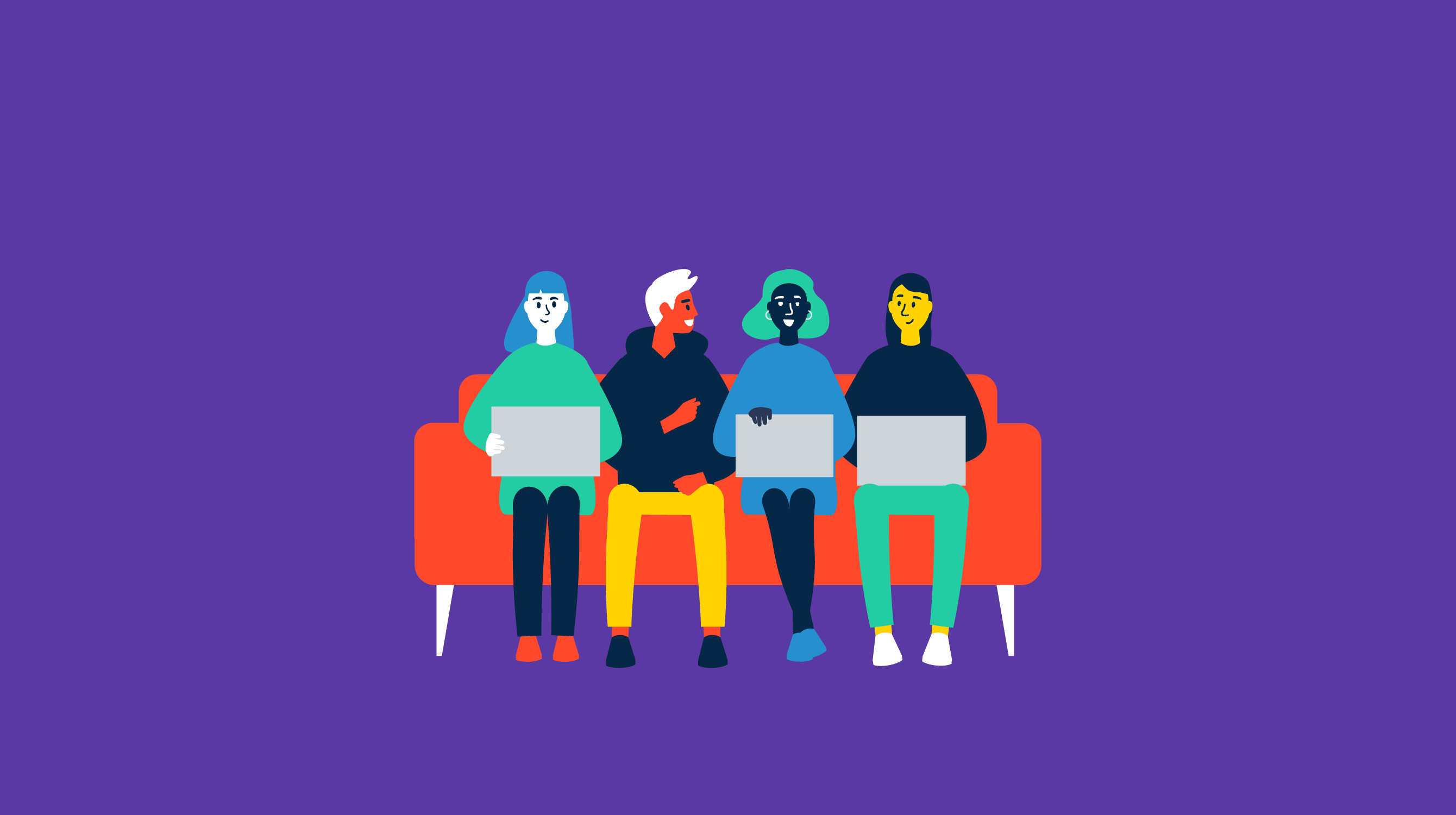June 23, 2020
 by Alexa Drake / June 23, 2020
by Alexa Drake / June 23, 2020

“You guys, Taylor was such a boss today at the networking event, we were manning our review booth like no other.”
No matter how well-intentioned you may be, odds are you’re using gendered words in the workplace. Using these words can inadvertently cause distress in the workplace. And while there’s a lot to learn, there’s no excuse for not educating yourself on gender-exclusive language and implementing strategies for diversity in the workplace.
Non-binary individuals face disproportionately high rates of exclusionary or discriminatory incidents. In fact, 42 percent of non-binary employees suffer from negative experiences in the workplace.
‘Diversity’ and ‘inclusion’ are common buzzwords that you see and hear in corporate meetings, HR initiatives, and recruiting documents. These words are thrown around to show that your company cares about everyone, but if employees don’t know how to be inclusive, these efforts will fall flat.
There’s more meaning to those words than just being welcoming to everyone. It goes deeper than that. Few companies are aware of the full spectrum of gender and the best way to implement these strategies is by ensuring there’s unwavering inclusivity, education, and allyship.
Companies are aware of the business case to foster a diverse and inclusive workplace, such as increased productivity and talent retention, but diversity isn’t just about hiring people with different skin colors or religions, it’s about allowing people to bring their whole selves to work.
Creating a work environment that fosters acceptance, support, and inclusivity is important for many reasons. According to research, 20 percent of non-binary employees believe they have lost a job because of their identity. Some of this discrimination comes from a place of misunderstanding and the other part comes from a place of hate.
Using gender-neutral language makes a big difference in the workplace. It makes everyone feel welcome, no matter their identity, and it sets an example for employees that gender-neutral language is the norm and that no one should assume anything about someone without asking first.
Once employees begin using gender-neutral language, a more natural acceptance will occur. People will begin noticing the gaps in their workplace and start to address them, like only having a male and female restroom available. When inclusion becomes a priority of everyone, the entire company benefits.
Employees are happier and more satisfied with their jobs, and thus more productive. Because of their higher satisfaction, there is lower turnover. When people feel valued and happy at their work they more easily work together so problem-solving increases. Lastly, accepting and including all perspectives allows for more creativity and innovation in the workplace.
As you begin to use gender-neutral language, you’ll soon see firsthand the importance of these efforts. But before you get started, be sure to learn the differences between commonly misunderstood words in gender identity conversations.
Let’s start with the basics. For centuries, most of modern society has been conditioned to believe a certain set of rules about sex and gender. This assumption is that there are two sexes (male and female) that match up with two genders (man and woman). As time has passed, the visibility of transgender, non-binary, and gender non-conforming individuals has become much more prominent and commonplace in our current world. These identities demonstrate that there aren’t just two gender identities and further proves that gender is fluid and can change over time.
Although these identities have existed for thousands of years, many people do not know the difference between them, let alone a simple definition. In the following section, we’ll discuss the difference between sex and gender and take a look at what it means to be transgender, cisgender, and non-binary.
Growing up, most of us were taught that there are two sexes: male and female. Although this was the concept we were taught as children, someone’s biological or assigned sex doesn’t always tell their full story.
To break it down simply, sex is a label that you’re assigned by a doctor at birth. Most of the world is assigned male or female which is the sex that is printed on their birth certificate. However, sex is more than just an M or F on a piece of paper. Someone’s sex is a combination of bodily characteristics including the genitals you were born with, your hormones, secondary sex characteristics, and the chromosomes you have.
Some people use the term biological sex instead of sex but in some circumstances, this term doesn’t cover how someone may feel on the inside. The term biological sex isn’t able to fully capture the variations in chromosome, biology, and anatomy that can occur as one ages and discovers who they are as a person. Having only two options (biological female or male) doesn’t leave any room for people who may be disconnected from one or both.
Instead of using sex or biological sex to refer to someone’s sex, consider using the term assigned male/female at birth. This term is more inclusive because it acknowledges that a doctor made the decision for you. When you use this term, you’re giving people the room to identify as they choose, even if their birth sex doesn’t match the way they feel inside or how they appear on the outside.
There are a few key elements that determine someone’s sex at birth. Some of these factors begin as early as fertilization of the egg:
In some cases, chromosomes, hormones, and body parts may happen to be arranged differently. When this occurs, the baby may be intersex.
Intersex is a term used for when a person is born with sexual or reproductive anatomy that doesn’t fit the stereotypical standards of male and female sexes. For example, someone might be born and look like a male on the outside, but possess mostly “female” anatomy on the inside. Additionally, someone can be born with genitals that look in-between the typically normal male and female types. It’s also possible to be born with mosaic genetics which means that some of the cells have XY chromosomes while others have XX.
Now that we’ve taken a look at what sex means, we can dive into the meaning of someone’s gender. Gender is a much more personal facet of someone’s personality and often includes gender roles, or a set of expectations society attaches to behaviors and characteristics. While your birth sex is assigned to you, you have the liberty to choose and express the gender identity you feel most comfortable in.
For example, transgender people feel a disconnect with the sex they were assigned at birth. They may identify much more with a gender identity that doesn’t match their sex. A large majority of people have a gender identity of either a man or woman (boy or girl for younger individuals). But for some people, the gender identity that goes along with their sex may make them uncomfortable and distressed. While they are assigned male at birth, they feel more like a woman on the inside. This is called gender dysphoria and we’ll touch on it later on.
Some people don’t have a gender identity that fits perfectly into the male or female sexes. These people may choose to identify as non-binary or genderqueer. We’ll talk about both of these terms further down.
Gender expression is the way in which an individual chooses to present themself in the world. It is visible to others while someone’s gender identity cannot be seen. Someone may express themselves through their name, clothing, pronouns, voice, haircut, or body language. The world will typically place each of these factors into either a masculine or feminine box but the beauty of gender expression is that when someone mixes a typically male haircut with a traditionally feminine outfit, they may feel more themselves because of it.
Usually, transgender people will try to align their gender identity with their gender expression, although not always. What is typically considered masculine or feminine has changed over time and will look different for every culture.
Someone’s sexual orientation is different than someone’s gender or gender identity. Someone’s sexual orientation refers to the genders they are attracted to and who they are physically, emotionally, and sexually drawn to. It’s about who you want to be in a relationship with rather than how you want to present or identify.
There are many identities associated with someone’s sexual orientation:
| Someone identifying as straight or heterosexual is only interested in people of the opposite sex (ex: a man who is attracted to women or a woman who is attracted to men). |
| Someone identifying as gay or homosexual is only interested in people of the same sex (ex: a man who is attracted to men or a woman who is attracted to women). Gay women sometimes prefer the term lesbian. |
| Someone identifying as bisexual is attracted to their own gender and people of other genders. |
| Someone identifying as pansexual or queer is attracted to many different identities. This can include men, women, transgender people, genderqueer people, and intersex people. |
| Anyone who is unsure of their sexual orientation may identify as questioning or curious. |
| Someone identifying as asexual does not experience any sexual attraction to anyone. |
It’s also possible that one discovers their sexual orientation later in life. These things have no set deadline and can take decades to come to the surface. Some people may not like labels at all and totally disengage from the idea altogether. It’s up to every person to decide how they want to identify, how they navigate relationships, and if they want to label themselves at all.
We’ve used the term transgender while explaining sex, gender, identity, and expression. But to truly understand it, we must strip it down to its core definition. Being transgender means that your gender identity or gender expression differs from the typical characteristics of your assigned sex at birth. When a person decides to transition (male to female or female to male), they can be prescribed hormones by their doctors to help bring their body closer to the gender identity they feel on the inside. Some people also undergo surgery but not all transgender people choose to do so. Still, they are just as trans as anyone who chooses to transition medically.
It’s important to discuss what gender dysphoria is when talking about transgender people. Gender dysphoria is the conflict between someone’s assigned gender and the gender with which they identify. A person with dysphoria may feel uncomfortable with the gender they were assigned, often stating that they’re uncomfortable in their own body. Dysphoria also refers to someone feeling disturbed by the gendered expectations of their assigned sex (ex: men wearing button-up shirts and ties or women wearing dresses).
Dysphoria cannot be understood by cisgender people. At the root of many (but not all) transgender people is this dysphoria. It can negatively affect trans people and push them to experiment with their clothing and self-image. This can be liberating for a transgender person and should be accepted in both personal and professional settings.
Cisgender (cis for short) is a term that is usually used within the LGBTQ+ community so many straight people may not know what it means. Put simply, someone is cisgender when they identify with the sex they were assigned at birth. If someone is born a female and never questions her gender identity, she is considered cisgender.
It’s also important to acknowledge the privilege that comes along with being cisgender. This privilege can go unnoticed by cis people until someone points it out to them. For example, imagine a cis person is told they have cisgender privilege and they respond with “How do I have privilege when I’m just a normal girl?” This is where the privilege starts. They are unknowingly referring to themselves as normal and insinuating that transgender people are abnormal.
It goes farther than this. Most (if not all) cisgender people don’t have to worry about whether they’ll be able to use a bathroom in public. For transgender people, this simple task can be a challenge and even threaten their safety. This issue even reaches up to our legislation. State legislators have the power to deny transgender people the right to use the bathroom of the gender they most identify with.
Simple things like passing as your gender in public and people using your correct name or pronoun are jeopardized when you are trans.
Other cisgender privileges include:
Cisgender people tend to take these things for granted and most of the time may not even acknowledge the privilege they have by being cis.
When someone identifies are non-binary, it means that their gender identity/expression doesn’t fit into the binary of man and woman. They may define their gender as falling somewhere between the two or even as something entirely different.
Some people may use non-binary and genderqueer interchangeably but there’s a difference between the two. Genderqueer means non-normative or queer gender while non-binary means a gender outside the typical binary model. It’s also significant to note that non-binary is not the same as transgender, although someone can identify as both.
When it comes to trans history, there are thousands of people who were involved in the timeline of what it means to be transgender. For the sake of brevity, we’ve highlighted five key figures who carved a path for trans people throughout the world.
In 1899, Magnus Hirschfeld began writing a journal called the Yearbook of Intermediate Sexual Types that talked about new ideas about sexual variations. This journal touched on what homosexuality was as well as what transvestism and transsexualismus are.
| Homosexuality: attraction to one's own gender. |
| Transvestism: dressing as another sex. |
| Transsexualismus: identifying as other sexes. |
In June 1969, Marsha P. Johnson and Sylvia Rivera held one of the most influential public demonstrations in LGBTQ+ history. Police raided the Stonewall Inn which was known as a trans and queer-friendly gathering place. At first, the struggle was only verbal but was soon shifted to physical interaction. This was later known as the Stonewall Riots. Efforts as such would not be possible without the involvement of black LGBTQ members like Marsha P. Johnson.
In 1998, Gwendolyn Smith founded the Transgender Day of Rememberance which is an annual vigil held worldwide on November 20th to remember the transgender and non-binary who were murdered that year.
In 2000, Monica Helms designed the transgender flag. She explained that the stripes on the top and bottom are blue, representing a baby boy. The stripes inward are pink, representing a baby girl. Finally, the stripe in the middle is white to signify those who are transitioning, intersex, or consider themselves having a neutral or unidentified gender. No matter which way you fly the trans flag, it will still be correct which was intentional and represents trans people finding “correctness” in their lives.
Learning how to use gender-neutral words isn’t usually something you were taught in school but swapping out some gendered words in your daily life can really make a difference. When you use a gender-neutral word, you are making the effort to include everyone, no matter if you know their gender or not. If a closeted person is in the room when you use a neutral word, it can make them feel more comfortable.
That being said, there are a number of ways you can change the way you speak and the words you use to be more inclusive. Instead of using the term wife or husband, you can substitute it for a partner or spouse. This takes the gender completely out of the situation. Instead of waiter or waitress, use server and “Hey, everyone” instead of “Hey, guys”.
Simple changes like this can make a world of difference to transgender, non-binary, and genderqueer people everywhere. Even if you think you know how everyone in the room identifies, using gender-neutral language can help to push other people to do the same and create a more inclusive environment for everyone.
Click to download our complete list of gender-neutral terms.
What happens if you’re not sure of someone’s gender? If you’re really not sure, you can ask them by saying “what pronouns do you prefer?” This can be difficult if you’re just meeting someone or if you don’t want to come off as forward or invasive. In this case, you can refer to them using the gender-neutral term “they” until you hear or are told otherwise. Always remember that using “they” is much less harmful than taking a guess and misgendering someone by accident.
Before talking about using pronouns, we should discuss why it’s important to respect someone’s pronouns and name. Using yourself as an example can show the importance of correct language pretty easily. Imagine out of the blue, someone came up to you and addressed you with the incorrect pronoun. If you’re comfortable with he/him/his pronouns and someone said “I think she’s got it covered” when referring to you, you’d be confused and probably want to correct them before they do it again.
This is how it feels for a transgender person when someone misgenders them. When they find the courage to come out to peers and family, it can be hurtful to hear a pronoun they don’t identify with or the name they were born with (called a deadname by the LGBTQ+ community). Using someone’s preferred pronouns shows them that you respect them and make them feel validated. It can even cause them to feel gender euphoria which is a state of happiness a trans person feels when someone uses their preferred pronouns/name.
Society teaches us that “he” and “she” are the only pronouns we need to know but as time has passed, this idea has changed to include people with different genders. Below is a graph you can use to start educating yourself on how to properly use pronouns.
As previously highlighted, non-binary individuals encounter problems in the workplace that invalidate their gender identity. In fact, 53 percent of LQBTQ+ workers report hearing jokes about lesbian or gay people at work.
States are divided on non-discrimination laws based on sexual orientation and gender identity. Non-discrimination laws protect LGBTQ+ individuals from being unfairly treated or discriminated against in the workplace.
Here are the states that by law explicitly prohibit discrimination based on sexual orientation and gender identity in the workplace:
| California | Nevada |
| Colorado | New Hampshire |
| Connecticut | New Jersey |
| Delaware | New Mexico |
| Hawaii | New York |
| Illinois | Oregon |
| Iowa | Rhode Island |
| Maine | Utah |
| Maryland | Vermont |
| Massachusetts | Washington |
| Minnesota | Washington D.C. |
The following states have no explicit prohibition laws for discrimination based on sexual orientation or gender identity:
| Alabama | Montana |
| Alaska | Nebraska |
| Arizona | North Carolina |
| Arkansas | North Dakota |
| Florida | Ohio |
| Georgia | Oklahoma |
| Idaho | South Carolina |
| Indiana | South Dakota |
| Kansas | Tennessee |
| Kentucky | Texas |
| Louisiana | Virginia |
| Mississippi | West Virginia |
| Missouri | Wyoming |
There are two states that explicitly interpret existing prohibition on sex discrimination to include sexual orientation and or gender identity. Those two states are Michigan and Pennsylvania.
Additionally, there’s only one state that explicitly prohibits discrimination based on sexual orientation only, and that’s Wisconsin.
So what are workplaces supposed to do in order to decrease the exclusion and increase the inclusion regardless of the state laws? It starts with allies stepping up to the plate and addressing any negative moments aimed at an individual who identifies as LGBTQ+.
With any work initiative, it starts from the top and trickles down. How leaders hold themselves will not only set a good example but also empower others to join the conversation.
In order to do this, these leaders must be open and honest about their level of dedication to LGBTQ+ inclusion within the company and must be comfortable addressing it head-on. Senior leadership can also outline initiatives that directly involve corporate inclusion so that it’s a set goal that the company must achieve.
Mid-level managers are the people who enable employees with the tools they need to be successful. These managers can lead the conversation about unconscious bias and provide a toolkit for their direct reports about what vocabulary to use. Lastly, they can foster team-bonding so that people from all different gender identities can get to know one another better.
Learn more: This article is just the first step to create a more inclusive workplace. Discover why being an ally in the workplace is so important.
Individual contributors first need to address their own biases. They need to educate themselves on gender-inclusive language and speak up when something seems wrong. Management cannot see everything that goes on, and usually, people are on their best behavior when around senior leaders.
Saying something matters. When someone is being disrespectful to someone in the . Even listening and not partaking adds to the issue. After becoming an LGBTQ+ ally yourself, you can begin taking more solid steps toward making the workplace more inclusive.
Now that you have the knowledge you need to enable your team to be more inclusive, here are some solid steps to take when implementing inclusion and diversity efforts.
Tip: Before you execute these best practices, gather and track employee satisfaction by using employee engagement software.
These efforts may seem simple, but they go a long way in making everyone feel comfortable bringing their whole selves to work every day.
Even if your company dresses business professional, make sure your employees know that it is a gender-neutral dress code. Women are not required to wear skirts and men are not required to wear pants. That view is dated and binary.
Instead, implement a dress code policy that avoids gender stereotypes and allows transgender employees to dress according to their full-time gender presentation.
It should go without saying, you should state values of inclusivity on your website or within your mission statement to make it clear that your company values all people no matter their gender identity.
If your budget allows for it, invest in diversity recruiting software. This software provides tools for redacting information that could inadvertently be used against a candidate including name, background, gender, and education.
Additionally, partner with LGBTQ+ organizations and networks to have job postings listed on their resources. If your company values diversity it will show through all of the other efforts made, and diverse talent will naturally come your way.
If your resources allow it, invest in diversity recruiting software
Prioritizing the comfort of everyone should be the main goal of most companies, especially when it comes to using the restroom.
Ideally, all companies would have gender-neutral restrooms with stalls. If the budget does not allow for this, there should be a separate gender-neutral restroom added. If neither of these accommodations can be made, then allow gender-nonconforming individuals to use whichever restroom they choose to without judgment.
Be sure to use ADA-compliant signage that doesn’t reinforce gender binaries. Simply call it an all-gender restroom and remove images of a male or female.
Job descriptions are the first thing to deter people from a company. Remove all gender bias in these descriptions. Titles that include words like “ninja,” or “superhero” lean more toward men. Also when describing tasks use “you” instead of “he/she.”
Then take a look at policies and records. Include options beyond male and female, give opportunities for employees to list their preferred name and pronoun.
There’s one thing to have a zero-tolerance policy and it’s another thing to actively enforce it. Workplaces should have policies that outline no tolerance for gender-based discrimination.
If an employee is found guilty of discriminatory acts, they should be let go.
If you or someone you know are facing a crisis or need support, contact the following resources*.
*If you think you may have a medical emergency, call your doctor, go to the emergency department, or call 911 immediately.
Gender-inclusivity starts with knowledge and 100% acceptance. You’re one step closer to fostering workplace inclusivity after reading this article, but don’t just talk the talk, walk the walk and implement these strategies today.
Alexa is a former content associate at G2. Born and raised in Chicago, she went to Columbia College Chicago and entered the world of all things event marketing and social media. In her free time, she likes being outside with her dog, creating playlists, and dabbling in Illustrator. (she/her/hers)
Move over, Alexa. Sayonara, Siri! Meet Q, the world’s first genderless voice assistant.
 by Rebecca Reynoso
by Rebecca Reynoso
Web accessibility implies giving everybody access to the same information irrespective of the...
 by Ashwini Dave
by Ashwini Dave
Sexist marketing and biased advertisements that undermine women, especially in tech, have been...
 by Sachin Gupta
by Sachin Gupta
Move over, Alexa. Sayonara, Siri! Meet Q, the world’s first genderless voice assistant.
 by Rebecca Reynoso
by Rebecca Reynoso
Web accessibility implies giving everybody access to the same information irrespective of the...
 by Ashwini Dave
by Ashwini Dave


